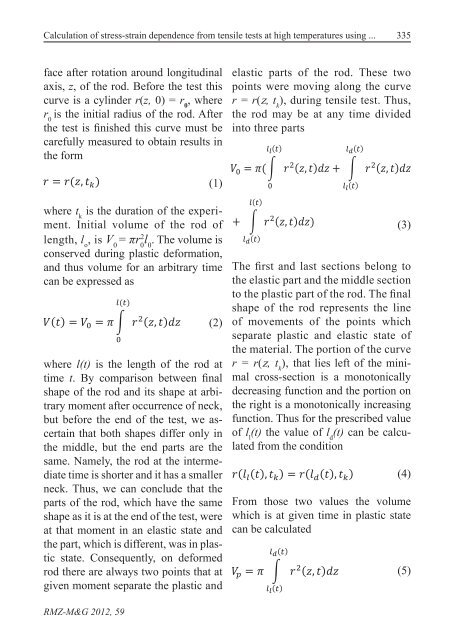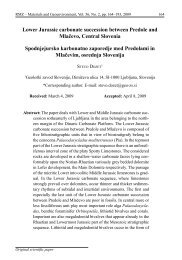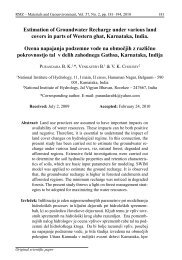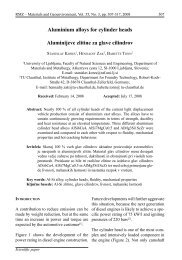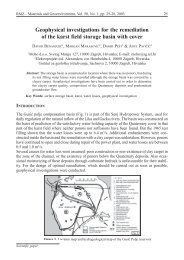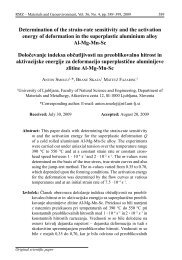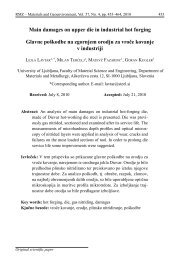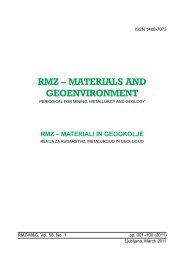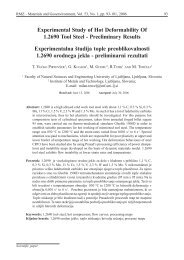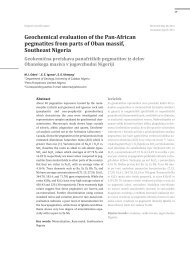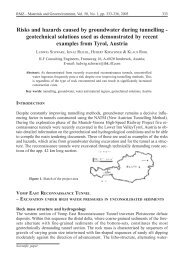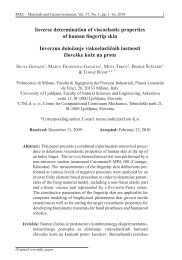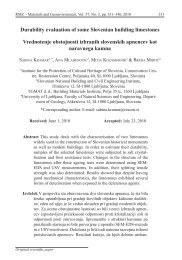334 Kugler, G., Terčelj, M., Peruš, I., Turk, R.Figure1. Dimension of specimen’s for tensile testing.(a)(b)Figure2. Schematic representation of temperature control (left), andshaping of contour (right) during hot tensile testing of Alloy201.The hot tensile tests were carried outon Gleeble 1500D thermomechanicaltesting machine. The samples were deformedbetween 8 mm and 11 mm attemperatures from 800 °C to 1000 °Cunder prescribed constant strain ratesbetween 10 –3 s –1 and 10 –1 s –1 assumingthat deformation was homogeneous onentire working length. The temperatureas a function of time during tensile testsis shown on Figure 2a, and specimenduring testing is shown on Figure 2b.Essentially the deformed shape-ofthe-rodafter tensile testing representsthe history of traveling of the crosssectionthat separates the elastic andplastic state of material. [3, 4] The portionof material that in a given momentleft the plastic state preserves its shapeuntil the end of the experiment.Basedon this fact, in what follows, the newmodel for description of evolution ofspecimen’s contours during tensiletesting will be introduced.Description of the mathematical approachModel for description of contour oftensile specimenA cylindrical rod of radius, r, maintainsits rotational symmetry aroundthe longitudinal axis, z, during a tensiletest, and thus its shape at giventime, t, is determined by the rotationalcurve r = r(z, t), which forms its sur-<strong>RMZ</strong>-M&G 2012, 59
Calculation of stress-strain dependence from tensile tests at high temperatures using ...335 = (, face after rotation around longitudinal elastic parts of the rod. These )twoaxis, z, of the rod. Before the test this points were moving along the () curvecurve is a cylinder r(z, 0) = r 0, where r = r(z, t k), during tensile test. Thus,r 0is the initial radius of the rod. After the rod may be () at = any = time divided (, ) = (, )the test is finished this curve must be into three partscarefully measured to obtain results () in () ()()the form() = = (, ) = ( (, ) + (, ) + = (, )(1)() () ()where t kis the duration of the experi- = = ( Initial (, volume (, ) ) + of the rod (, ) of + (, ))(3)( (), ) = ( (), )() = ment.length, l o, is V 0= πr 2 l 0. The volume is () () ()0conserved during plastic deformation, = (, )and ()thus volume ( for (), ()an arbitrary ) = ( time (), The ) first and last sections belong to, ) + can be expressed (, ) as + = (, ) ()(, ))the elastic part and the middle section ()to the plastic part of the rod. The final ()() ()( (), ) = ( (), ) = ( (), ) = (, )shape of the rod represents the line( (2) of movements of the points which (),() ) =( = (), ) (, ) (, )separate plastic and elastic = (, state () = (, ))of the material. The portion () of the curve () () ( (), ) = ( (), ) = ( (), ) () ()where l(t) is the length of the rod at r = r(z, t k), that lies left of the minimal) cross-section is a monotonically = (, ) = time t. By ()()(, )(, )( (, ) + comparison (, )between + final (, )(, )shape ()of the rod andits shape= (, () = ) = (, )at arbitrarymoment after occurrence of neck, the right is a () monotonically increasing = (, decreasing function )and () the portionon () () () () ()(), ) =but( before(), )the= (end (),ofthe ) ( test, we ascertainthat both shapes differ only in of l lfunction. Thus for the prescribed value (), ) (, = () (), )(t) the value of l d(t) can be calculated ()(, ) the middle, = (, but = (, () ()()) () = (, ) = ( () the end () ()= (, ) = + (, (, )) + (, ))parts are the from the () condition () () same. () Namely, the rod () at the intermediate = time is shorter (, ) () () ()()and it has a smaller(4)(, ) neck. = Thus, (, we () )can conclude that the = ( (, (, ) () = (), ) = ( (), ) = ( (, (, ) ) + ) parts () of the rod, which () have the same From those two +1 + ) ) () () () values the () volume ( (),shape)as=it(is at(),the)end= (of the (),test, )were which is at given time in plastic stateat that ()moment in an elastic state and can be calculated(, ) () = the part, which (, = ) is (, different, )( was in plastic ) = = = (, )( (, ) (, ) (), ) = ( (), ) ()state. Consequently, 1 + () on deformed() () ()( ( (), ) = ( (), ) ) = ( (), ) rod there are always two points that at(5)(,given )moment = separate (, = (, ))the plastic and = ( (, ) + (, )) (, ) (, ) ( 1 + () ) = (, ) () = (, ()) <strong>RMZ</strong>-M&G 2012, 59 () () ( (), ) = ( (), ) = ( (), ) () ( ) = ( (, ) + (, )) (, () = ) (, ))() () ()
- Page 4 and 5: IVTable of Contents - KazaloProfess
- Page 7: Calculation of stress-strain depend
- Page 11 and 12: () = (, )() () ()Calculation
- Page 13 and 14: , ) (, )(, ) 1 () + = (, ) =
- Page 15 and 16: Calculation of stress-strain depend
- Page 17 and 18: Calculation of stress-strain depend
- Page 19 and 20: Calculation of stress-strain depend
- Page 21 and 22: RMZ - Materials and Geoenvironment,
- Page 23 and 24: Petrochemical characteristics and g
- Page 25 and 26: Petrochemical characteristics and g
- Page 27 and 28: Petrochemical characteristics and g
- Page 29 and 30: Petrochemical characteristics and g
- Page 31 and 32: Petrochemical characteristics and g
- Page 34 and 35: 360 Akinola, O. O., Talabi, A. O.A
- Page 36 and 37: 362 Akinola, O. O., Talabi, A. O.of
- Page 38 and 39: 364 Sunmonu, L. A., Adagunodo, T. A
- Page 40 and 41: 366 Sunmonu, L. A., Adagunodo, T. A
- Page 42 and 43: 368 Sunmonu, L. A., Adagunodo, T. A
- Page 44 and 45: 370 Sunmonu, L. A., Adagunodo, T. A
- Page 46 and 47: 372 Sunmonu, L. A., Adagunodo, T. A
- Page 48 and 49: 374 Sunmonu, L. A., Adagunodo, T. A
- Page 50 and 51: 376 Sunmonu, L. A., Adagunodo, T. A
- Page 52 and 53: 378 Sunmonu, L. A., Adagunodo, T. A
- Page 54 and 55: 380 Sunmonu, L. A., Adagunodo, T. A
- Page 56 and 57: 382 Sunmonu, L. A., Adagunodo, T. A
- Page 58 and 59:
384 Sunmonu, L. A., Adagunodo, T. A
- Page 60 and 61:
386 Sunmonu, L. A., Adagunodo, T. A
- Page 62 and 63:
388 Sunmonu, L. A., Adagunodo, T. A
- Page 64 and 65:
390 Sunmonu, L. A., Adagunodo, T. A
- Page 66 and 67:
392 Shemetov, P. A., Bibik, I. P.in
- Page 68 and 69:
394 Shemetov, P. A., Bibik, I. P.
- Page 70 and 71:
k =1.05+Dλ = 1+k =( s )396 Shemeto
- Page 72 and 73:
398 Shemetov, P. A., Bibik, I. P.si
- Page 74 and 75:
у 3 b400 D = f eShemetov, P. A., B
- Page 76 and 77:
V4BEK Q σBEad = ,commQрσV 01 +
- Page 78 and 79:
404 Shemetov, P. A., Bibik, I. P.wh
- Page 80 and 81:
thrмR iλ = 2 λ= 100⋅exp[ −(
- Page 82 and 83:
qLevel of average technical (theore
- Page 84 and 85:
.6670.05=0.35k1,05+D avet( s3≥ Kt
- Page 86 and 87:
RMZ-M&G 2012, 59
- Page 88 and 89:
414 Adewale, A., Olawale, O. O., Ma
- Page 90 and 91:
416 Adewale, A., Olawale, O. O., Ma
- Page 92 and 93:
418 Adewale, A., Olawale, O. O., Ma
- Page 94 and 95:
420 Adewale, A., Olawale, O. O., Ma
- Page 96 and 97:
422 Adewale, A., Olawale, O. O., Ma
- Page 98 and 99:
424 Adewale, A., Olawale, O. O., Ma
- Page 100 and 101:
426 Adewale, A., Olawale, O. O., Ma
- Page 102 and 103:
RMZ-M&G 2012, 59
- Page 104 and 105:
430 Kos, A., Dervarič, E.novega ve
- Page 106 and 107:
432 Kos, A., Dervarič, E.diamond w
- Page 108 and 109:
434 Kos, A., Dervarič, E.chines to
- Page 110 and 111:
436 Kos, A., Dervarič, E.the best
- Page 112 and 113:
438 Kos, A., Dervarič, E.Before th
- Page 114 and 115:
440 Kos, A., Dervarič, E.nally to
- Page 116 and 117:
RMZ-M&G 2012, 59
- Page 118 and 119:
444 Lajovic, A.disc brakes, further
- Page 120 and 121:
446 Lajovic, A.Slika 2. Izrez iz Si
- Page 122 and 123:
448 Lajovic, A.Livne lonce smo na n
- Page 124 and 125:
450 Lajovic, A.Ingersol pa je bil z
- Page 126 and 127:
452 Lajovic, A.Med delavci, ki so b
- Page 128 and 129:
454 Lajovic, A.imel vsak delavec na
- Page 130 and 131:
456 Lajovic, A.Slika 5. Izdelki Že
- Page 132 and 133:
458 Lajovic, A.pa se ni najbolje iz
- Page 134 and 135:
460 Lajovic, A.za delo. Promet na z
- Page 136 and 137:
462 Lajovic, A.Sredi osemdesetih le
- Page 138 and 139:
464 Lajovic, A.njem delu forme. Na
- Page 140 and 141:
466 Lajovic, A.Enourni film je mars
- Page 142 and 143:
RMZ-M&G 2012, 59
- Page 144 and 145:
470 Medved, J., Rosina, A., Vončin
- Page 146 and 147:
472 Author’s IndexAuthor`s Index,
- Page 148 and 149:
RMZ-M&G 2012, 59
- Page 150 and 151:
Contents476Phase contrast method fo
- Page 152:
Contents47859/4Calculation of stres
- Page 155 and 156:
Instructions to authors481Compositi
- Page 157 and 158:
Instructions to authors483NAVODILA
- Page 159 and 160:
Instructions to authors485Knjige:Ro
- Page 161 and 162:
Template487TEMPLATEThe title of the
- Page 163 and 164:
Template489References (Times New Ro
- Page 165 and 166:
Template491Obstajata dve sprejemlji


